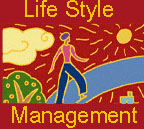|
|
In the following the Web pages are for quick access and the Word documents are the final versions of the chapter.
Cover Page Text and Excerpts: Download Word document.
About the Authors: Download Web page, Word document. Introduction (8 pp.) -- Farrokh Alemi and David AronLays out the book's outline and differentiates the book from other books on weight loss and exercise (download Web page or Word document).
Chapter 1: Workbook for Weight Loss and Exercise (28 pp.) —Farrokh Alemi, Duncan Neuhauser, Linda Headrick, and Shirley M. Moore, Nancy Tinsley, Ethel Smith, and David Aron Gives a step-by-step guide to ecological approaches to diet and exercise. It shows how one's environment can be changed so that diet and exercise plans can be maintained over time (download Web page or Word document).
Chapter 2: Does Self-Improvement Work? Effectiveness of Changing Personal Environments to Achieve Behavior Change (12 pp.) -- Farrokh Alemi, Duncan Neuhauser, and Linda Norman Self-help books, in general, and this book, by extension, have been criticized for promising early and easy success. We examine the experience of more than 150 people to see if our claims are supported by their experiences (download Web page or Word document).
Chapter 3: System Thinking in a Personal Context (32 pp.) —Farrokh Alemi, Lisa Pawloski, William F Fallon Jr. and Nancy Tinsley Explains what system thinking is and how it can be applied in the context of weight loss and exercise (download Web page or Word document).
Chapter 4: Improvement Teams: Getting Help from Family and Friends (13 pp.) —Farrokh Alemi, Laura Benson, and Robert DillDiscusses how to put together a team of "process owners" to work on changing the environment. It distinguishes between a process owner and a buddy and provides the functions and meeting procedures for improvement teams (download Web page or Word document). Chapter 5: Tools for Understanding Complex Processes: Flowcharts and Lists of Periodic Events (11 pp.) —Farrokh Alemi and Ashraf IsmailShows how to study existing life processes and routines. It provides tools such as flowcharts and a list of periodic events that are to model life processes (download Web page or Word document). Chapter 6: Control Charts for Diet and Exercise (10 pp.) —Farrokh Alemi and Duncan Neuhauser Demonstrates progress monitoring of weight loss and exercise. It describes the use of control charts for distinguishing real improvements from historical patterns of rises and falls in weight and exercise frequency (download Web page or Word document). Chapter 7: Mary Loses Weight by Exercising (31 pp.) —Laura BensonProvides a detailed example of how one person used the book’s recommendations to lose weight and exercise more (download Web page or Word document).
Chapter 8: Review -- Duncan Neuhauser Provides a review of the entire book and key concepts (download web page or Word document)
References: Download Word document.
Appendix
-- Farrokh Alemi
Ethics of Self Improvement (5 pp.) -- Farrokh Alemi Discusses the ethical issues inherent in self-change including what if people diet or exercise beyond what is healthy (download the Word document or Web page).
Web resources -- Farrokh Alemi Read more about Web resources available through George Mason University (download the Word document or the Web page)
(~ 160 pp. chapters + ~ 7 pp. appendix files: ~167 pp.)
Copyright © 2003 This book is copyright protected by Farrokh Alemi, Ph.D. It is presented on the Web in order to assist improvement. Please send your comments to the authors of the respective chapters or to Dr. Alemi. If you wish to use a portion of the book, please do so with appropriate citation. This book is part of the course on quality improvement, the project on personal improvement. This page was drafted first in January 2000. It was last revised on 02/04/2009.
|
